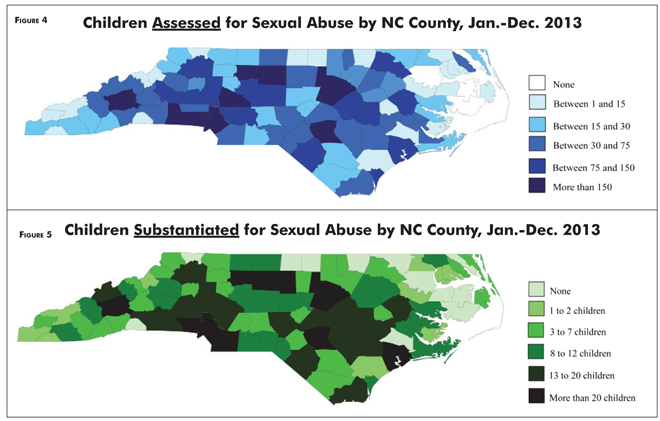 |
 |
 |
Vol.
20, No. 2
April 2015
CSA Interviews in North Carolina: By the Numbers
Figures and data in this article are from Duncan, 2015
What do administrative data tell us about child sexual abuse interviews and sex abuse victims in NC?
CPS assessments
In December 2014, North Carolina county DSS agencies employed 1,023 CPS assessors (NC DSS, 2015). When child maltreatment reports are accepted, these individuals conduct an assessment with the child and family.
The number of children involved in CPS assessments each month has been gradually increasing. Between January 2000 and April 2014, about 11,800 children were assessed each month.
Sexual abuse interviews
Hundreds of the CPS assessments conducted each month concern sexual abuse. Figure 1 shows the number of NC children assessed and substantiated for sexual abuse each month between 2006 and 2014. Most of these assessments likely involved a child sexual abuse interview.

Substantiated victims
In North Carolina only a minority of CPS assessments for allegations of sexual abuse result in substantiation of sexual abuse. A variety of factors may contribute to this. Some reports simply are unfounded, though when this happens there is usually no malicious intent. Other times, sexual abuse has occurred but CPS substantiates for something else (e.g., neglect/lack of supervision). In some cases CPS can't identify the perpetrator.
In other instances children are not believed, though research suggests fictitious allegations of sexual abuse from children are quite uncommon, comprising 3% or less of all sexual abuse reports (sources cited in Faller, 2007).

Each month from 2006-2014, between 59 and 147 NC children were found to be victims of sex abuse. Most were between the ages of 6 and 12, followed by youth ages 13-18. Relatively few victims were under age 6.
To see the numbers of children assessed and substantiated for child sexual abuse in specific NC counties, see the figures below.

Unexpected disclosures
Sometimes an agency gets involved with a family for one reason only to discover sexual abuse has also occurred. As Figure 3 shows, for an average of 5-10% of the children substantiated as sex abuse victims each month, the initial report did not allege sex abuse. Some children disclose sexual abuse only after months or years in foster care, when they finally feel safe.

Caution and limitations
Administrative data are an imperfect tool for estimating the number of sex abuse victims. Most victims likely go uncounted. Reasons can include: they were abused by someone other than a caretaker, they did not disclose the abuse, their disclosure for some reason did not result in substantiation, or the sexual abuse was not tracked due to a coding error. Many victims do not disclose until adulthood.
